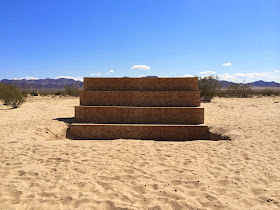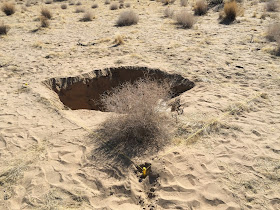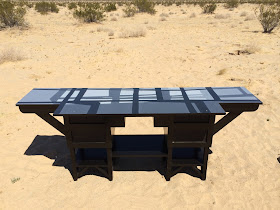Site 1: 79017 El Paseo Drive, Wonder Valley, CA 92277
Dick Hedbidge
Rebecca Bennett Duke
Ken Ehrlich
Norm Laich
Site 2: Ironage Road, Wonder Valley, CA 92277
Megan Mueller
Justin Lowman
Lara Bank
Nate Page
Jay Lizo
Marco Rios
Michael Dodge
Matthew Usinowicz
Nuttaphol Ma
Anastasia Hill
Sam Scharf
Ken Ehrlich
Ruchama Noorda
Oliver Hess
Olga Koumoundouros
To bemoan a sprawling, open-ended group show for such an exhibition of artworks would be an understatement, and that's the good news. Situated on two separate parcels of land (El Paseo and Ironage Roads approximately twenty minutes apart) at the eastern edge of the "high" desert, approximately three hours from the sandy beaches of Los Angeles, "Spectacular Subdivision," curated and organized by fellow artist Jay Lizo, proposed a wide-range of artist interpretations of land usage as it pertains to housing and artistic operations, that is to say the relationship between art and life.
As one of the artists involved, I had the distinct pleasure of getting to know more intimately the people and the places surrounding the events. While I learned many things during this time, the most painful reminder is just how difficult it is to synthesize such an array of projects into any kind of succinct statement. Every time I think I have one, I locate the exception; that's a good thing. As with most such situations, I am left to share a few observations, ones that focus between the givens of the sites and the others that the artists brought through his/her vision. Think light, land, color, and wind plus bodies and construction materials.
Before I continue, I must also disclaim that I spent the majority of my time at the Ironage site and am remiss to not have gotten more pics from the El Paseo portion. That said, I do have a few here.
Thought most artists took up residency in one or the other site, two artists (Olga Koumoundouros and Ken Ehrlich) hedged their bets by installing works in both locations, In both instances, it made sense to me as they both seemed to complicate notions of interiority/exteriority, concepts that could be taken as a subtheme of this exhibition. Koumoundouros photographed, printed, and displayed her installed work from Ironage Road in the kitchen at El Paseo (a nice commentary regarding representation and displacement via what gets posted on the refrigerator) while Ehrlich installed furniture outside at both sites. For me, both artists suggested that the expanse between sites shared common ground.
This common ground, as most artists would surely attest at Ironage Road, was unstable and elusive at best. Some dug in, literally and massively, to get a sense of how the surface related to a more remote depth (Page, Dodge, Rios, and Ma). One couldn't help but recall the line from Casino about holes in the desert. Others played with the vernacular of local architecture past, present, and future (Mueller, Noorda, Hess, Lizo, and Lowman). Yet others, somewhere in between, evoked the lyrical and absurd (Bennet Duke, Laich, Bank, Usinowicz, and Scharf). In all cases, it was clear that the land informed the work in some way. If static works were not enough, several artists used his and her bodies to invoke intangibles of each place. Dick Hedbidge performed exhortations regarding desert life as retreat. While Anastasia Hill reflected harsh reality and longing through recitation of prison letters (Hill). In either case, the message was clear that sublime, desert conditions can produce intense, internal states. So, somewhere between literal and poetic interpretations of the sites and locale, a large band of artists suffered harsh conditions (particularly fickle high winds and shifting sands) in order to demonstrate his/her own ethos regarding art-making and display within the framework of some notion of settlement and domesticity.
While the thesis of the show led viewers toward works that could easily be contextualized within a suburban, "subdivision" aesthetic, let's say, I couldn't help but think about larger narratives involving recent art history (Smithson, Heizer, and Holt) and less tangible notions of geologic time (levels of permanence). Somehow the latter registered more noticeably in this place. As we trudged aimlessly through the sand, occasionally "falling through" a top thin layer (not unlike ice) it was clear that this beach was nowhere near the next large body of water, but its signs were everywhere.
As a result, I may ultimately begin to consider how to think about populating a region of such startlingly challenging conditions and simultaneously, remotely familiar. If I were to begin thinking about what it takes to survive any such conditions, natural resources and energy transformation in relation to this exhibition, heating and cooling (necessary factors for desert life, yes?) for example, I might start to think more clearly about works that address available energy and fuel (electrical, solar, refrigeration, human endeavor, et al...). If we were to return to this exhibition with such a filter in mind, we may locate the common ground of energy consumption and displacement as an interesting one, one that has most of us behaving simultaneously locally and and globally through telecommunications while also posing greater wonders regarding sustainability, not just of life but also of art practices. Point in fact, we survived the weekend by texting and probably couldn't have mounted such an exhibition otherwise. Certainly, this factor sets apart such a showing from what has come before in similar locales historically speaking, not to mention this was very much a group effort as opposed to an individual artist's singular vision.
While I was really hoping to avoid heavy metaphors such as "wandering through the desert for forty years," it's difficult not to consider as both artists and visitors trudged aimlessly all weekend between points hoping to gain some semblance of understanding, and at the very least, enjoyment. Thankfully, such an endeavor was, in actuality, only fifty-six hours, and, I believe, good times were had by all.
In closing, I couldn't help but wonder from time to time in the moment and subsequently now about how heavily reliant on digital telecommunications to survive the travails of the weekend we were. Certainly, such connectivity is what allowed this show to be what it was practically, and clearly different artistically from the kind of remoteness that was possible even just forty or fifty-odd years ago. Perhaps, the quest for "beyond silence" that Hedbidge addressed in his performance Friday night was toward a main point (eventually silence (nothing?) responds), one that I was able to enjoy with the strongest works in this showing, the ones that complicated the expanse of land and sky and various points in between (Dodge, Page, and Mueller).
While I could delve into greater details regarding some of the best examples in my opinion, I'll let the pictures posted here carry the weight of my perspective. For there was something so picturesque about the forty-acre installation at Site 2: Ironage Road, and most artists took advantage of this. Think parkland but different. Whatever the views, many of us agreed that the mountains to the north were stunning.



































































































While I was at Site 2: Ironage Road, it seemed like I couldn't take my eyes off the mesmerizing mountains to the north. It was like we were ants carrying bits of sand next to them...thanks for your insights. Norm Laich
ReplyDeleteThat particular view, indeed, was nice. I think Nate Page's work featured it best. I agree, that the scale was striking as well. Thanks for looking.
ReplyDelete